社会成本问题-科斯
社会成本问题—科斯

社会成本问题﹡罗纳德·科斯一、有待分析的问题1本文涉及对他人产生有害影响的那些工商业企业的行为。
一个典型的例子就是,某工厂的烟尘给邻近的财产所有者带来了有害影响。
对此类情况,经济学的分析通常是从工厂的私人产品与社会产品之间分歧的观点展开的。
在这一方面,许多经济学家都因袭了庇古在《福利经济学》中提出的观点。
他们的分析结论无非是要求工厂主对烟尘所引起的损害负责赔偿,或者根据工厂不同的烟尘排放量及其所致损害的相应金额标准对工厂主征税,或者最终责令该厂迁出居民区(当然也指烟尘排放对他人产生有害影响的地区)。
以我之见,这些解决办法并不合适,因为它们所导致的结果不是人们所需要的,甚至通常也不是人们所满意的。
二、问题的交互性质传统的方法掩盖了不得不作出的选择的实质。
人们一般将该问题视为甲给乙造成损害,因而所要决定的是:如何制止甲?但这是错误的。
我们正在分析的问题具有交互性质,即避免对乙的损害将会使甲遭受损害,必须决定的真正问题是:是允许甲损害乙,还是允许乙损害甲?关键在于避免较严重的损害。
我在以前的文章2中列举了糖果制造商的机器引起的噪声和震动干扰了某医生的工作的事例。
为了避免损害医生,糖果制造商将遭受损害。
此事例提出的问题实质上是,是否值得去限制糖果制造商采用的生产方法,并以减少其产品供给的代价来保证医生的正常工作。
另一事例是走失的牛损坏邻近土地里的谷物所产生的问题。
倘若有些牛难免要走失,那么只有以减少谷物的供给这一代价来换取肉类供给的增加。
这种选择的实质是显而易见的:是要肉类,还是要谷物?当然,我们不能贸然回答,除非我们知道所得到的价值是什么,以及为此所牺牲的价值是什么。
再举一例:乔治·J·施蒂格勒教授提到的河流污染问题3。
如果我们假定污染的有害后果是鱼类的死亡,要决定的问题则是:鱼类损失的价值究竟大于还是小于可能污染河流的产品的价值。
不言而喻,必须从总体的和边际的角度来看待这一问题。
科斯-社会成本问题

The Problem of Social CostR.H.Coase University of Virginia1.The Problem to Be Examined1This paper is concerned with those actions of businessfirms which have harmful effects on others.The standard example is that of a factory the smoke from which has harmful effects on those occupying neighbouring properties.The economic analysis of such a situation has usually proceeded in terms of a di-vergence between the private and social product of the factory,in which econ-omists have largely followed the treatment of Pigou in The Economics of Welfare. The conclusions to which this kind of analysis seems to have led most economists is that it would be desirable to make the owner of the factory liable for the dam-age caused to those injured by the smoke,or alternatively,to place a tax on the factory owner varying with the amount of smoke produced and equivalent in money terms to the damage it would cause,orfinally,to exclude the factory from residential districts(and presumably from other areas in which the emission of smoke would have harmful effects on others).It is my contention that the suggested courses of action are inappropriate,in that they lead to results which are not necessarily,or even usually,desirable.2.The Reciprocal Nature of the ProblemThe traditional approach has tended to obscure the nature of the choice that has to be made.The question is commonly thought of as one in which A inflicts harm on B and what has to be decided is:how should we restrain A?But this is wrong.We are dealing with a problem of a reciprocal nature.To avoid the harm to B would inflict harm on A.The real question that has to be decided is:should A be allowed to harm B or should B be allowed to harm A?The 1This article,although concerned with a technical problem of economic analysis,arose out of the study of the Political Economy of Broadcasting which I am now conducting.The argument of the present article was implicit in a previous article dealing with the problem of allocating radio and television frequencies(The Federal Communications Commission,w&Econ.[1959])but comments which I have received seemed to suggest that it would be desirable to deal with the question in a more explicit way and without reference to the original problem for the solution of which the analysis was developed.[Journal of Law and Economics,vol.56(November2013)]᭧1960by The University of Chicago.All rights reserved.0022-2186/2013/5604-0025$10.00837838The Journal of LAW&ECONOMICSproblem is to avoid the more serious harm.I instanced in my previous article2 the case of a confectioner the noise and vibrations from whose machinery dis-turbed a doctor in his work.To avoid harming the doctor would inflict harm on the confectioner.The problem posed by this case was essentially whether it was worth while,as a result of restricting the methods of production which could be used by the confectioner,to secure more doctoring at the cost of a reduced supply of confectionery products.Another example is afforded by the problem of straying cattle which destroy crops on neighbouring land.If it is inevitable that some cattle will stray,an increase in the supply of meat can only be obtained at the expense of a decrease in the supply of crops.The nature of the choice is clear:meat or crops.What answer should be given is,of course, not clear unless we know the value of what is obtained as well as the value of what is sacrificed to obtain it.To give another example,Professor George J. Stigler instances the contamination of a stream.3If we assume that the harmful effect of the pollution is that it kills thefish,the question to be decided is:is the value of thefish lost greater or less than the value of the product which the contamination of the stream makes possible.It goes almost without saying that this problem has to be looked at in total and at the margin.3.The Pricing System with Liability for DamageI propose to start my analysis by examining a case in which most economists would presumably agree that the problem would be solved in a completely satisfactory manner:when the damaging business has to pay for all damage caused and the pricing system works smoothly(strictly this means that the operation of a pricing system is without cost).A good example of the problem under discussion is afforded by the case of straying cattle which destroy crops growing on neighbouring land.Let us suppose that a farmer and a cattle-raiser are operating on neighbouring properties.Let us further suppose that,without any fencing between the properties,an increase in the size of the cattle-raiser’s herd increases the total damage to the farmer’s crops.What happens to the marginal damage as the size of the herd increases is another matter.This depends on whether the cattle tend to follow one another or to roam side by side,on whether they tend to be more or less restless as the size of the herd increases and on other similar factors.For my immediate purpose, it is immaterial what assumption is made about marginal damage as the size of the herd increases.To simplify the argument,I propose to use an arithmetical example.I shall assume that the annual cost of fencing the farmer’s property is$9and that the price of the crop is$1per ton.Also,I assume that the relation between the number of cattle in the herd and the annual crop loss is as follows:2Coase,The Federal Communications Commission,w&Econ.26–27(1959).3G.J.Stigler,The Theory of Price105(1952).The Problem of Social Cost839Number in Herd(Steers)Annual Crop Loss(Tons)Crop Loss per AdditionalSteer(Tons)1112323634104Given that the cattle-raiser is liable for the damage caused,the additional annual cost imposed on the cattle-raiser if he increased his herd from,say,2to 3steers is$3and in deciding on the size of the herd,he will take this into account along with his other costs.That is,he will not increase the size of the herd unless the value of the additional meat produced(assuming that the cattle-raiser slaughters the cattle)is greater than the additional costs that this will entail, including the value of the additional crops destroyed.Of course,if,by the employment of dogs,herdsmen,aeroplanes,mobile radio and other means,the amount of damage can be reduced,these means will be adopted when their cost is less than the value of the crop which they prevent being lost.Given that the annual cost of fencing is$9,the cattle-raiser who wished to have a herd with4 steers or more would pay for fencing to be erected and maintained,assuming that other means of attaining the same end would not do so more cheaply.When the fence is erected,the marginal cost due to the liability for damage becomes zero,except to the extent that an increase in the size of the herd necessitates a stronger and therefore more expensive fence because more steers are liable to lean against it at the same time.But,of course,it may be cheaper for the cattle-raiser not to fence and to pay for the damaged crops,as in my arithmetical example,with3or fewer steers.It might be thought that the fact that the cattle-raiser would pay for all crops damaged would lead the farmer to increase his planting if a cattle-raiser came to occupy the neighbouring property.But this is not so.If the crop was previously sold in conditions of perfect competition,marginal cost was equal to price for the amount of planting undertaken and any expansion would have reduced the profits of the farmer.In the new situation,the existence of crop damage would mean that the farmer would sell less on the open market but his receipts for a given production would remain the same,since the cattle-raiser would pay the market price for any crop damaged.Of course,if cattle-raising commonly in-volved the destruction of crops,the coming into existence of a cattle-raising industry might raise the price of the crops involved and farmers would then extend their planting.But I wish to confine my attention to the individual farmer.I have said that the occupation of a neighbouring property by a cattle-raiser would not cause the amount of production,or perhaps more exactly the amount of planting,by the farmer to increase.In fact,if the cattle-raising has any effect, it will be to decrease the amount of planting.The reason for this is that,for any given tract of land,if the value of the crop damaged is so great that the receipts from the sale of the undamaged crop are less than the total costs of cultivating that tract of land,it will be profitable for the farmer and the cattle-raiser to840The Journal of LAW&ECONOMICSmake a bargain whereby that tract of land is left uncultivated.This can be made clear by means of an arithmetical example.Assume initially that the value of the crop obtained from cultivating a given tract of land is$12and that the cost incurred in cultivating this tract of land is$10,the net gain from cultivating the land being$2.I assume for purposes of simplicity that the farmer owns the land.Now assume that the cattle-raiser starts operations on the neighbouring property and that the value of the crops damaged is$1.In this case$11is obtained by the farmer from sale on the market and$1is obtained from the cattle-raiser for damage suffered and the net gain remains$2.Now suppose that the cattle-raiserfinds it profitable to increase the size of his herd,even though the amount of damage rises to$3;which means that the value of the additional meat production is greater than the additional costs,including the additional $2payment for damage.But the total payment for damage is now$3.The net gain to the farmer from cultivating the land is still$2.The cattle-raiser would be better off if the farmer would agree not to cultivate his land for any payment less than$3.The farmer would be agreeable to not cultivating the land for any payment greater than$2.There is clearly room for a mutually satisfactory bargain which would lead to the abandonment of cultivation.4But the same argument applies not only to the whole tract cultivated by the farmer but also to any subdivision of it.Suppose,for example,that the cattle have a well-defined route, say,to a brook or to a shady area.In these circumstances,the amount of damage to the crop along the route may well be great and if so,it could be that the farmer and the cattle-raiser wouldfind it profitable to make a bargain whereby the farmer would agree not to cultivate this strip of land.But this raises a further possibility.Suppose that there is such a well-defined route.Suppose further that the value of the crop that would be obtained by cultivating this strip of land is$10but that the cost of cultivation is$11.In the absence of the cattle-raiser,the land would not be cultivated.However,given the presence of the cattle-raiser,it could well be that if the strip was cultivated, the whole crop would be destroyed by the cattle.In which case,the cattle-raiser would be forced to pay$10to the farmer.It is true that the farmer would lose $1.But the cattle-raiser would lose$10.Clearly this is a situation which is not likely to last indefinitely since neither party would want this to happen.The aim of the farmer would be to induce the cattle-raiser to make a payment in return 4The argument in the text has proceeded on the assumption that the alternative to cultivation of the crop is abandonment of cultivation altogether.But this need not be so.There may be crops which are less liable to damage by cattle but which would not be as profitable as the crop grown in the absence of damage.Thus,if the cultivation of a new crop would yield a return to the farmer of$1instead of$2,and the size of the herd which would cause$3damage with the old crop would cause$1damage with the new crop,it would be profitable to the cattle-raiser to pay any sum less than$2to induce the farmer to change his crop(since this would reduce damage liability from$3 to$1)and it would be profitable for the farmer to do so if the amount received was more than$1 (the reduction in his return caused by switching crops).In fact,there would be room for a mutually satisfactory bargain in all cases in which a change of crop would reduce the amount of damage by more than it reduces the value of the crop(excluding damage)—in all cases,that is,in which a change in the crop cultivated would lead to an increase in the value of production.The Problem of Social Cost841 for an agreement to leave this land uncultivated.The farmer would not be able to obtain a payment greater than the cost of fencing off this piece of land nor so high as to lead the cattle-raiser to abandon the use of the neighbouring property.What payment would in fact be made would depend on the shrewdness of the farmer and the cattle-raiser as bargainers.But as the payment would not be so high as to cause the cattle-raiser to abandon this location and as it would not vary with the size of the herd,such an agreement would not affect the allocation of resources but would merely alter the distribution of income and wealth as between the cattle-raiser and the farmer.I think it is clear that if the cattle-raiser is liable for damage caused and the pricing system works smoothly,the reduction in the value of production else-where will be taken into account in computing the additional cost involved in increasing the size of the herd.This cost will be weighed against the value of the additional meat production and,given perfect competition in the cattle industry,the allocation of resources in cattle-raising will be optimal.What needs to be emphasized is that the fall in the value of production elsewhere which would be taken into account in the costs of the cattle-raiser may well be less than the damage which the cattle would cause to the crops in the ordinary course of events.This is because it is possible,as a result of market transactions,to discontinue cultivation of the land.This is desirable in all cases in which the damage that the cattle would cause,and for which the cattle-raiser would be willing to pay,exceeds the amount which the farmer would pay for use of the land.In conditions of perfect competition,the amount which the farmer would pay for the use of the land is equal to the difference between the value of the total production when the factors are employed on this land and the value of the additional product yielded in their next best use(which would be what the farmer would have to pay for the factors).If damage exceeds the amount the farmer would pay for the use of the land,the value of the additional product of the factors employed elsewhere would exceed the value of the total product in this use after damage is taken into account.It follows that it would be desirable to abandon cultivation of the land and to release the factors employed for production elsewhere.A procedure which merely provided for payment for dam-age to the crop caused by the cattle but which did not allow for the possibility of cultivation being discontinued would result in too small an employment of factors of production in cattle-raising and too large an employment of factors in cultivation of the crop.But given the possibility of market transactions,a situation in which damage to crops exceeded the rent of the land would not endure.Whether the cattle-raiser pays the farmer to leave the land uncultivated or himself rents the land by paying the land-owner an amount slightly greater than the farmer would pay(if the farmer was himself renting the land),thefinal result would be the same and would maximise the value of production.Even when the farmer is induced to plant crops which it would not be profitable to cultivate for sale on the market,this will be a purely short-term phenomenon and may be expected to lead to an agreement under which the planting will842The Journal of LAW&ECONOMICScease.The cattle-raiser will remain in that location and the marginal cost of meat production will be the same as before,thus having no long-run effect on the allocation of resources.4.The Pricing System with No Liability for DamageI now turn to the case in which,although the pricing system is assumed to work smoothly(that is,costlessly),the damaging business is not liable for any of the damage which it causes.This business does not have to make a payment to those damaged by its actions.I propose to show that the allocation of resources will be the same in this case as it was when the damaging business was liable for damage caused.As I showed in the previous case that the allocation of resources was optimal,it will not be necessary to repeat this part of the argument.I return to the case of the farmer and the cattle-raiser.The farmer would suffer increased damage to his crop as the size of the herd increased.Suppose that the size of the cattle-raiser’s herd is3steers(and that this is the size of the herd that would be maintained if crop damage was not taken into account). Then the farmer would be willing to pay up to$3if the cattle-raiser would reduce his herd to2steers,up to$5if the herd were reduced to1steer and would pay up to$6if cattle-raising was abandoned.The cattle-raiser would therefore receive$3from the farmer if he kept2steers instead of3.This$3 foregone is therefore part of the cost incurred in keeping the third steer.Whether the$3is a payment which the cattle-raiser has to make if he adds the third steer to his herd(which it would be if the cattle-raiser was liable to the farmer for damage caused to the crop)or whether it is a sum of money which he would have received if he did not keep a third steer(which it would be if the cattle-raiser was not liable to the farmer for damage caused to the crop)does not affect thefinal result.In both cases$3is part of the cost of adding a third steer, to be included along with the other costs.If the increase in the value of production in cattle-raising through increasing the size of the herd from2to3is greater than the additional costs that have to be incurred(including the$3damage to crops),the size of the herd will be increased.Otherwise,it will not.The size of the herd will be the same whether the cattle-raiser is liable for damage caused to the crop or not.It may be argued that the assumed starting point—a herd of3steers—was arbitrary.And this is true.But the farmer would not wish to pay to avoid crop damage which the cattle-raiser would not be able to cause.For example,the maximum annual payment which the farmer could be induced to pay could not exceed$9,the annual cost of fencing.And the farmer would only be willing to pay this sum if it did not reduce his earnings to a level that would cause him to abandon cultivation of this particular tract of land.Furthermore,the farmer would only be willing to pay this amount if he believed that,in the absence of any payment by him,the size of the herd maintained by the cattle-raiser wouldThe Problem of Social Cost843 be4or more steers.Let us assume that this is the case.Then the farmer would be willing to pay up to$3if the cattle-raiser would reduce his herd to3steers, up to$6if the herd were reduced to2steers,up to$8if one steer only were kept and up to$9if cattle-raising were abandoned.It will be noticed that the change in the starting point has not altered the amount which would accrue to the cattle-raiser if he reduced the size of his herd by any given amount.It is still true that the cattle-raiser could receive an additional$3from the farmer if he agreed to reduce his herd from3steers to2and that the$3represents the value of the crop that would be destroyed by adding the third steer to the herd. Although a different belief on the part of the farmer(whether justified or not) about the size of the herd that the cattle-raiser would maintain in the absence of payments from him may affect the total payment he can be induced to pay, it is not true that this different belief would have any effect on the size of the herd that the cattle-raiser will actually keep.This will be the same as it would be if the cattle-raiser had to pay for damage caused by his cattle,since a receipt foregone of a given amount is the equivalent of a payment of the same amount. It might be thought that it would pay the cattle-raiser to increase his herd above the size that he would wish to maintain once a bargain had been made, in order to induce the farmer to make a larger total payment.And this may be true.It is similar in nature to the action of the farmer(when the cattle-raiser was liable for damage)in cultivating land on which,as a result of an agreement with the cattle-raiser,planting would subsequently be abandoned(including land which would not be cultivated at all in the absence of cattle-raising).But such manoeuvres are preliminaries to an agreement and do not affect the long-run equilibrium position,which is the same whether or not the cattle-raiser is held responsible for the crop damage brought about by his cattle.It is necessary to know whether the damaging business is liable or not for damage caused since without the establishment of this initial delimitation of rights there can be no market transactions to transfer and recombine them.But the ultimate result(which maximises the value of production)is independent of the legal position if the pricing system is assumed to work without cost.5.The Problem Illustrated AnewThe harmful effects of the activities of a business can assume a wide variety of forms.An early English case concerned a building which,by obstructing currents of air,hindered the operation of a windmill.5A recent case in Florida concerned a building which cast a shadow on the cabana,swimming pool and sunbathing areas of a neighbouring hotel.6The problem of straying cattle and the damaging of crops which was the subject of detailed examination in the two preceding sections,although it may have appeared to be rather a special case, 5See Gale on Easements237–39(13th ed.M.Bowles1959).6See Fontainebleu Hotel Corp.v.Forty-Five Twenty-Five,Inc.,114So.2d357(1959).844The Journal of LAW&ECONOMICSis in fact but one example of a problem which arises in many different guises. To clarify the nature of my argument and to demonstrate its general applicability, I propose to illustrate it anew by reference to four actual cases.Let usfirst reconsider the case of Sturges v.Bridgman7which I used as an illustration of the general problem in my article on“The Federal Communi-cations Commission.”In this case,a confectioner(in Wigmore Street)used two mortars and pestles in connection with his business(one had been in operation in the same position for more than60years and the other for more than26 years).A doctor then came to occupy neighbouring premises(in Wimpole Street). The confectioner’s machinery caused the doctor no harm until,eight years after he hadfirst occupied the premises,he built a consulting room at the end of his garden right against the confectioner’s kitchen.It was then found that the noise and vibration caused by the confectioner’s machinery made it difficult for the doctor to use his new consulting room.“In particular...the noise prevented him from examining his patients by auscultation8for diseases of the chest.He also found it impossible to engage with effect in any occupation which required thought and attention.”The doctor therefore brought a legal action to force the confectioner to stop using his machinery.The courts had little difficulty in granting the doctor the injunction he sought.“Individual cases of hardship may occur in the strict carrying out of the principle upon which we found our judgment,but the negation of the principle would lead even more to individual hardship,and would at the same time produce a prejudicial effect upon the development of land for residential purposes.”The court’s decision established that the doctor had the right to prevent the confectioner from using his machinery.But,of course,it would have been possible to modify the arrangements envisaged in the legal ruling by means of a bargain between the parties.The doctor would have been willing to waive his right and allow the machinery to continue in operation if the confectioner would have paid him a sum of money which was greater than the loss of income which he would suffer from having to move to a more costly or less convenient location or from having to curtail his activities at this location or,as was suggested as a possibility,from having to build a separate wall which would deaden the noise and vibration.The confectioner would have been willing to do this if the amount he would have to pay the doctor was less than the fall in income he would suffer if he had to change his mode of operation at this location,abandon his operation or move his confectionery business to some other location.The solution of the problem depends essentially on whether the continued use of the machinery adds more to the confectioner’s income than it subtracts from the doctor’s.9But now consider the situation if the confectioner had won the case.The confectioner 711Ch.D.852(1879).8Auscultation is the act of listening by ear or stethoscope in order to judge by sound the condition of the body.9Note that what is taken into account is the change in income after allowing for alterations in methods of production,location,character of product,etc.The Problem of Social Cost845 would then have had the right to continue operating his noise and vibration-generating machinery without having to pay anything to the doctor.The boot would have been on the other foot:the doctor would have had to pay the confectioner to induce him to stop using the machinery.If the doctor’s income would have fallen more through continuance of the use of this machinery than it added to the income of the confectioner,there would clearly be room for a bargain whereby the doctor paid the confectioner to stop using the machinery. That is to say,the circumstances in which it would not pay the confectioner to continue to use the machinery and to compensate the doctor for the losses that this would bring(if the doctor had the right to prevent the confectioner’s using his machinery)would be those in which it would be in the interest of the doctor to make a payment to the confectioner which would induce him to discontinue the use of the machinery(if the confectioner had the right to operate the ma-chinery).The basic conditions are exactly the same in this case as they were in the example of the cattle which destroyed crops.With costless market transac-tions,the decision of the courts concerning liability for damage would be without effect on the allocation of resources.It was of course the view of the judges that they were affecting the working of the economic system—and in a desirable direction.Any other decision would have had“a prejudicial effect upon the development of land for residential purposes,”an argument which was elaborated by examining the example of a forge operating on a barren moor,which was later developed for residual purposes.The judges’view that they were settling how the land was to be used would be true only in the case in which the costs of carrying out the necessary market transactions exceeded the gain which might be achieved by any rearrangement of rights.And it would be desirable to preserve the areas(Wimpole Street or the moor)for residential or professional use(by giving non-industrial users the right to stop the noise,vibration,smoke,etc., by injunction)only if the value of the additional residential facilities obtained was greater than the value of cakes or iron lost.But of this the judges seem to have been unaware.Another example of the same problem is furnished by the case of Cooke v. Forbes.10One process in the weaving of cocoa-nutfibre matting was to immerse it in bleaching liquids after which it was hung out to dry.Fumes from a man-ufacturer of sulphate of ammonia had the effect of turning the matting from a bright to a dull and blackish colour.The reason for this was that the bleaching liquid contained chloride of tin,which,when affected by sulphuretted hydrogen, is turned to a darker colour.An injunction was sought to stop the manufacturer from emitting the fumes.The lawyers for the defendant argued that if the plaintiff “were not to use...a particular bleaching liquid,theirfibre would not be affected;that their process is unusual,not according to the custom of the trade, and even damaging to their own fabrics.”The judge commented:“...it appears to me quite plain that a person has a right to carry on upon his own property 10L.R.5Eq.166(1867–1868).。
《社会成本问题》 罗纳德.科斯
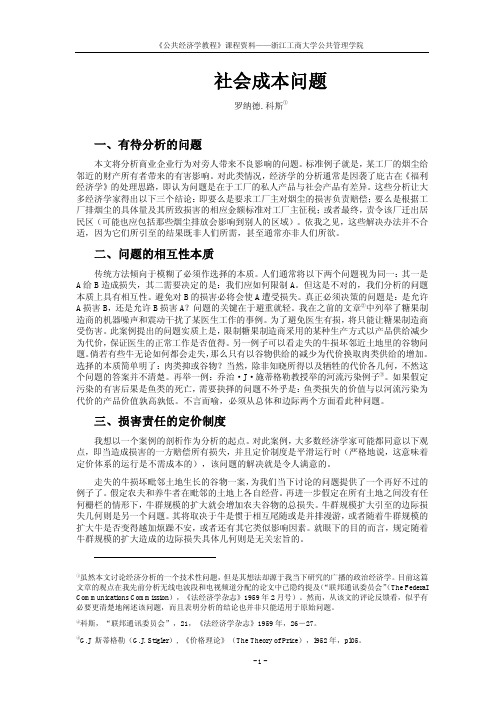
社会成本问题罗纳德.科斯①一、有待分析的问题本文将分析商业企业行为对旁人带来不良影响的问题。
标准例子就是,某工厂的烟尘给邻近的财产所有者带来的有害影响。
对此类情况,经济学的分析通常是因袭了庇古在《福利经济学》的处理思路,即认为问题是在于工厂的私人产品与社会产品有差异。
这些分析让大多经济学家得出以下三个结论:即要么是要求工厂主对烟尘的损害负责赔偿;要么是根据工厂排烟尘的具体量及其所致损害的相应金额标准对工厂主征税;或者最终,责令该厂迁出居民区(可能也应包括那些烟尘排放会影响到别人的区域)。
依我之见,这些解决办法并不合适,因为它们所引至的结果既非人们所需,甚至通常亦非人们所欲。
二、问题的相互性本质传统方法倾向于模糊了必须作选择的本质。
人们通常将以下两个问题视为同一:其一是A给B造成损失,其二需要决定的是:我们应如何限制A。
但这是不对的,我们分析的问题本质上具有相互性。
避免对B的损害必将会使A遭受损失。
真正必须决策的问题是:是允许A损害B,还是允许B损害A?问题的关键在于避重就轻。
我在之前的文章②中列举了糖果制造商的机器噪声和震动干扰了某医生工作的事例。
为了避免医生有损,将只能让糖果制造商受伤害。
此案例提出的问题实质上是,限制糖果制造商采用的某种生产方式以产品供给减少为代价,保证医生的正常工作是否值得。
另一例子可以看走失的牛损坏邻近土地里的谷物问题。
倘若有些牛无论如何都会走失,那么只有以谷物供给的减少为代价换取肉类供给的增加。
选择的本质简单明了:肉类抑或谷物?当然,除非知晓所得以及牺牲的代价各几何,不然这个问题的答案并不清楚。
再举一例:乔治·J·施蒂格勒教授举的河流污染例子③。
如果假定污染的有害后果是鱼类的死亡,需要抉择的问题不外乎是:鱼类损失的价值与以河流污染为代价的产品价值孰高孰低。
不言而喻,必须从总体和边际两个方面看此种问题。
三、损害责任的定价制度我想以一个案例的剖析作为分析的起点。
《社会成本问题》主要观点述评

《社会成本问题》主要观点述评《社会成本问题》读书笔记关键词:外部性;交易成本;权利界定;资源配置主要内容科斯《社会成本问题》讨论的主要问题是外部侵害,并提出“市场交易成本”的概念,研究了权利的初始界定对资源配置的影响,并对庇古的福利经济学的观点进行质疑与反驳。
科斯首先从工厂对居民的烟尘污染这一经典例子指出外部性侵害具有交互性,要避免对乙的损害就会使甲受到损害,所以,我们应该从总体和边际的角度来衡量双方损害价值的大小,不能简单地评判谁赔偿谁。
接着科斯在交易成本为零的前提下,分别讨论了对损害负有责任和对损害不负责任的定价制度。
他以走失的牛损坏邻近土地的谷物生长一案为例,分析了养牛者和农夫的行为。
得出的结论是:他们的具体做法要视成本而定,双方交易的结果是最终利润最大化,资源配置最优化。
但在现实生活中,交易成本是实际存在的,无论是通过市场、企业或政府哪一方来解决损害问题都需要付出一定的成本。
科斯特别强调法律制度对经济体系运行和资源配置所起到的重要作用,在选择合适的社会安排时,关键是要根据具体情况看哪一种解决方式交易成本更小、总产值最大。
之后的部分则是对庇古《福利经济学》的一些批判,如损害即赔偿的研究方法显然没有比较交互双方价值的大小,也没有考虑到安排后的社会制度可能会带来更多的损害。
科斯提倡研究方法要改变,即在设计和选择社会格局时应该考虑总的效果。
主要观点述评《社会成本问题》最主要的贡献在于提出了我们常说的“科斯定理”——在交易费用为零时,无论初始权利如何配置,市场的自由交易都可使资源的到最佳配置。
但在现实生活中,交易成本不可能为零,所以也就更加提醒了我们法律与制度的安排对于资源配置是十分重要的。
我国正处在经济转型时期,改革的交易成本问题一直十分突出。
如何衡量改革的收益与成本,选择交易成本最小的路径,实现社会收益的最大化?在环境、公共建设等问题上,如何采取有效的措施来解决负外部性问题,也是一种产权的初始界定与经济效率问题。
科斯的《社会成本》读书笔记
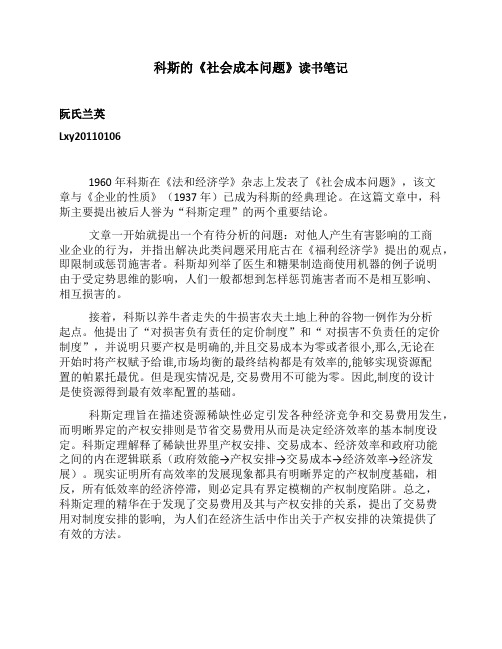
科斯的《社会成本问题》读书笔记阮氏兰英Lxy201101061960年科斯在《法和经济学》杂志上发表了《社会成本问题》,该文章与《企业的性质》(1937年)已成为科斯的经典理论。
在这篇文章中,科斯主要提出被后人誉为“科斯定理”的两个重要结论。
文章一开始就提出一个有待分析的问题:对他人产生有害影响的工商业企业的行为,并指出解决此类问题采用庇古在《福利经济学》提出的观点,即限制或惩罚施害者。
科斯却列举了医生和糖果制造商使用机器的例子说明由于受定势思维的影响,人们一般都想到怎样惩罚施害者而不是相互影响、相互损害的。
接着,科斯以养牛者走失的牛损害农夫土地上种的谷物一例作为分析起点。
他提出了“对损害负有责任的定价制度”和“对损害不负责任的定价制度”,并说明只要产权是明确的,并且交易成本为零或者很小,那么,无论在开始时将产权赋予给谁,市场均衡的最终结构都是有效率的,能够实现资源配置的帕累托最优。
但是现实情况是, 交易费用不可能为零。
因此,制度的设计是使资源得到最有效率配置的基础。
科斯定理旨在描述资源稀缺性必定引发各种经济竞争和交易费用发生,而明晰界定的产权安排则是节省交易费用从而是决定经济效率的基本制度设定。
科斯定理解释了稀缺世界里产权安排、交易成本、经济效率和政府功能之间的内在逻辑联系(政府效能→产权安排→交易成本→经济效率→经济发展)。
现实证明所有高效率的发展现象都具有明晰界定的产权制度基础,相反,所有低效率的经济停滞,则必定具有界定模糊的产权制度陷阱。
总之,科斯定理的精华在于发现了交易费用及其与产权安排的关系,提出了交易费用对制度安排的影响, 为人们在经济生活中作出关于产权安排的决策提供了有效的方法。
科斯针对庇古在《福利经济学》中的研究和庇古观点进行评价。
按照庇古的观点国家是不需要的而是由内在的市场价值寻求改变。
科斯提出了政府应该有所做的,如果仅随着市场自身的改变,就会造成很大的损害。
这就是庇古理论的不足和实践上的不可能性。
浅析科斯的《社会成本问题》

浅析科斯的《社会成本问题》浅析科斯的《社会成本问题》[摘要] 科斯所著的《社会成本问题》被国际经济学界公认为现代产权理论的经典之作,其精髓之处在于交易成本的提出和产权的初始界定。
《社会成本问题》可以看作是对交易成本理论在制度选择方面的进一步扩展,同时也拓宽了产权理论研究的视野。
本文通过对《社会成本问题》脉络进行简要梳理,加深对交易成本地理解,从而得出对我国国企及经济体制改革的启示。
[关键词] 交易成本;社会成本;产权;法律制度《社会成本问题》是1991年诺贝尔经济学奖获得者科斯赢得该奖的代表作,是现代产权经济学的核心内容。
它包含了许多重要的经济思想,如损害具有相互性、交易成本为正、初始权利界定的重要性等。
通过对《社会成本问题》中的流行观点加以辨析,对于正确认识科斯的产权思想和深化现代产权理论研究,有着正本清源的意义。
1 《社会成本问题》的简要回顾《社会成本问题》是科斯为了阐述关于外部损害问题的观点而发表的,其一共分为十节。
在写作手法上,科斯用更形象、更丰富、更有说服力的例子来证明完善的产权界定可以解决外部性问题。
他在文章的开头提出:将某个工厂的烟尘给邻近的财产所有者带来的有害影响,看作是前者损害了后者,即甲损害了乙,因而决定制止甲,这是错误的。
原因是:损害问题具有相互性,如果甲在生产或者经营活动过程中妨碍了乙,是甲损害了乙,但停止甲的活动,以避免损害乙却又损害了甲。
总而言之,只要有经济活动,必定就有损害。
社会成本讲求的是经济理论,出发点是“理性人”的假设,因此不能像道德或法律所规定的那样。
更有可能的是,它会把原告和被告的角色互换,看得是总体对整个社会更有益处。
由此可见,外部损害交互性质的本质和核心应是从总体和边际的角度来衡量双方损害价值的大小,不能简单地评判谁赔偿谁。
接下来科斯以交易成本为零为前提,分别讨论了对损害负有责任和对损害不负责任的定价制度。
科斯强调权利的初始界定,从而得出权利的初始界定是进行市场交易的前提这个重要的思想。
科斯《社会成本问题》
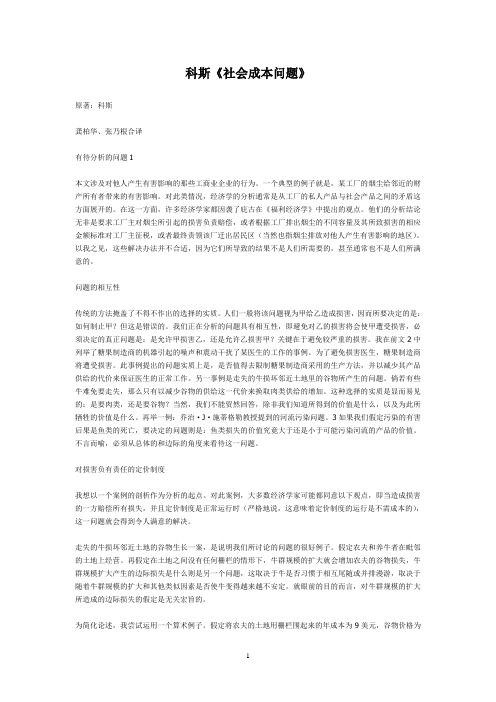
科斯《社会成本问题》原著:科斯龚柏华、张乃根合译有待分析的问题1本文涉及对他人产生有害影响的那些工商业企业的行为。
一个典型的例子就是,某工厂的烟尘给邻近的财产所有者带来的有害影响。
对此类情况,经济学的分析通常是从工厂的私人产品与社会产品之间的矛盾这方面展开的。
在这一方面,许多经济学家都因袭了庇古在《福利经济学》中提出的观点。
他们的分析结论无非是要求工厂主对烟尘所引起的损害负责赔偿,或者根据工厂排出烟尘的不同容量及其所致损害的相应金额标准对工厂主征税,或者最终责领该厂迁出居民区(当然也指烟尘排放对他人产生有害影响的地区)。
以我之见,这些解决办法并不合适,因为它们所导致的结果不是人们所需要的,甚至通常也不是人们所满意的。
问题的相互性传统的方法掩盖了不得不作出的选择的实质。
人们一般将该问题视为甲给乙造成损害,因而所要决定的是:如何制止甲?但这是错误的。
我们正在分析的问题具有相互性,即避免对乙的损害将会使甲遭受损害,必须决定的真正问题是:是允许甲损害乙,还是允许乙损害甲?关键在于避免较严重的损害。
我在前文2中列举了糖果制造商的机器引起的噪声和震动干扰了某医生的工作的事例。
为了避免损害医生,糖果制造商将遭受损害。
此事例提出的问题实质上是,是否值得去限制糖果制造商采用的生产方法,并以减少其产品供给的代价来保证医生的正常工作。
另一事例是走失的牛损坏邻近土地里的谷物所产生的问题。
倘若有些牛难免要走失,那么只有以减少谷物的供给这一代价来换取肉类供给的增加。
这种选择的实质是显而易见的:是要肉类,还是要谷物?当然,我们不能贸然回答,除非我们知道所得到的价值是什么,以及为此所牺牲的价值是什么。
再举一例:乔治·J·施蒂格勒教授提到的河流污染问题。
3如果我们假定污染的有害后果是鱼类的死亡,要决定的问题则是:鱼类损失的价值究竟大于还是小于可能污染河流的产品的价值。
不言而喻,必须从总体的和边际的角度来看待这一问题。
《社会成本问题》 罗奈德科斯

社会成本问题罗纳德.科斯①一、有待分析的问题本文将分析商业企业行为对旁人带来不良影响的问题。
标准例子就是,某工厂的烟尘给邻近的财产所有者带来的有害影响。
对此类情况,经济学的分析通常是因袭了庇古在《福利经济学》的处理思路,即认为问题是在于工厂的私人产品与社会产品有差异。
这些分析让大多经济学家得出以下三个结论:即要么是要求工厂主对烟尘的损害负责赔偿;要么是根据工厂排烟尘的具体量及其所致损害的相应金额标准对工厂主征税;或者最终,责令该厂迁出居民区(可能也应包括那些烟尘排放会影响到别人的区域)。
依我之见,这些解决办法并不合适,因为它们所引至的结果既非人们所需,甚至通常亦非人们所欲。
二、问题的相互性本质传统方法倾向于模糊了必须作选择的本质。
人们通常将以下两个问题视为同一:其一是A给B造成损失,其二需要决定的是:我们应如何限制A。
但这是不对的,我们分析的问题本质上具有相互性。
避免对B的损害必将会使A遭受损失。
真正必须决策的问题是:是允许A损害B,还是允许B损害A?问题的关键在于避重就轻。
我在之前的文章②中列举了糖果制造商的机器噪声和震动干扰了某医生工作的事例。
为了避免医生有损,将只能让糖果制造商受伤害。
此案例提出的问题实质上是,限制糖果制造商采用的某种生产方式以产品供给减少为代价,保证医生的正常工作是否值得。
另一例子可以看走失的牛损坏邻近土地里的谷物问题。
倘若有些牛无论如何都会走失,那么只有以谷物供给的减少为代价换取肉类供给的增加。
选择的本质简单明了:肉类抑或谷物?当然,除非知晓所得以及牺牲的代价各几何,不然这个问题的答案并不清楚。
再举一例:乔治·J·施蒂格勒教授举的河流污染例子③。
如果假定污染的有害后果是鱼类的死亡,需要抉择的问题不外乎是:鱼类损失的价值与以河流污染为代价的产品价值孰高孰低。
不言而喻,必须从总体和边际两个方面看此种问题。
三、损害责任的定价制度我想以一个案例的剖析作为分析的起点。
社会成本问题
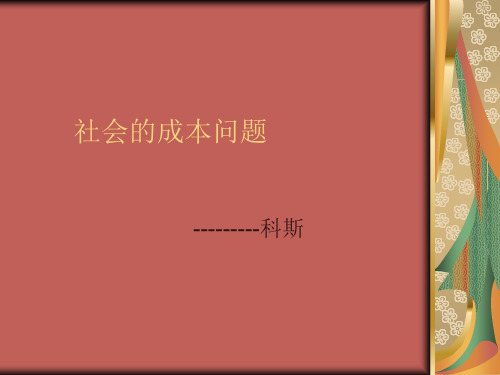
产权外部性
产权:是描述人们可以对他们的财产做什么 的法律规则。它包括所有权、使用权、收益 权和转让权。 外部性又称为溢出效应、外部影响或外差效 应,指一个人或一群人的行动和决策使另一 个人或一群人受损或受益的情况。 产权外部性 应该就是由于某人的使用自己财 产权利时的动作行为等对其余人造成了损失。
外部经济产生的原因: 科斯认为,外部经济产生的根本原因 是产权界定不够明确或界定不当。所 以政府不必一定要用干预的方法来试 图消除社会收益或成本与私人收益或 成本之间的差异,政府只需界定并保 护产权,而随后产生的市场交易就能 达到帕累托最优。
原文节选—科斯不同意庇古的看法
庇古的分析怎么会得出错误的结论呢?原因 在于庇古似乎并没有注意到他的分析所针对 的是完全不同的问题。他的分析是正确的, 但他得出的具体结论却是不合逻辑的。(火车
发动机产生火星的事件)
他们的分析结论无非是要求工厂主对烟尘所 引起的损害负责赔偿,或者根据工厂排出烟 尘的不同容量及其所致损害的相应金额标准 对工厂主征税,或者最终责令该厂迁出居民 区(当然也指烟尘排放对他人产生有害影响 的地区),以我之见,这些解决办法并不合 适,因为它们所导致的结果不是人们所需要 的,甚至通常也不是人们所满意的。(关于庇
总结文章内容: 简单来说,《社会成本问题》就是讨 论解决事件外部性的方法。并通过很 多案列,如牛和谷物,糖果商和医生, 编制草席的厂和会产生二氧化硫的厂, 烟囱事件,建筑物挡风影响风车问题 等就外部性讨论事件中甲乙双方的利 益问题,如何平衡解决甲乙双方的利 益争论的一系列延伸讨论。
产权的内涵
(1)它是人与物之间的归属关系,但其实质 是依附于物上面的人与人之间的关系; (2)在资源无限供给或者零交易成本下,产 权是不起作用的; (3)产权表现为一权利束,它包括占有权、 使用权、收益权等方面。
《社会成本问题》 罗纳德.科斯

社会成本问题罗纳德.科斯①一、有待分析的问题本文将分析商业企业行为对旁人带来不良影响的问题。
标准例子就是,某工厂的烟尘给邻近的财产所有者带来的有害影响。
对此类情况,经济学的分析通常是因袭了庇古在《福利经济学》的处理思路,即认为问题是在于工厂的私人产品与社会产品有差异。
这些分析让大多经济学家得出以下三个结论:即要么是要求工厂主对烟尘的损害负责赔偿;要么是根据工厂排烟尘的具体量及其所致损害的相应金额标准对工厂主征税;或者最终,责令该厂迁出居民区(可能也应包括那些烟尘排放会影响到别人的区域)。
依我之见,这些解决办法并不合适,因为它们所引至的结果既非人们所需,甚至通常亦非人们所欲。
二、问题的相互性本质传统方法倾向于模糊了必须作选择的本质。
人们通常将以下两个问题视为同一:其一是A给B造成损失,其二需要决定的是:我们应如何限制A。
但这是不对的,我们分析的问题本质上具有相互性。
避免对B的损害必将会使A遭受损失。
真正必须决策的问题是:是允许A损害B,还是允许B损害A?问题的关键在于避重就轻。
我在之前的文章②中列举了糖果制造商的机器噪声和震动干扰了某医生工作的事例。
为了避免医生有损,将只能让糖果制造商受伤害。
此案例提出的问题实质上是,限制糖果制造商采用的某种生产方式以产品供给减少为代价,保证医生的正常工作是否值得。
另一例子可以看走失的牛损坏邻近土地里的谷物问题。
倘若有些牛无论如何都会走失,那么只有以谷物供给的减少为代价换取肉类供给的增加。
选择的本质简单明了:肉类抑或谷物?当然,除非知晓所得以及牺牲的代价各几何,不然这个问题的答案并不清楚。
再举一例:乔治·J·施蒂格勒教授举的河流污染例子③。
如果假定污染的有害后果是鱼类的死亡,需要抉择的问题不外乎是:鱼类损失的价值与以河流污染为代价的产品价值孰高孰低。
不言而喻,必须从总体和边际两个方面看此种问题。
三、损害责任的定价制度我想以一个案例的剖析作为分析的起点。
社会成本问题-展示-科斯
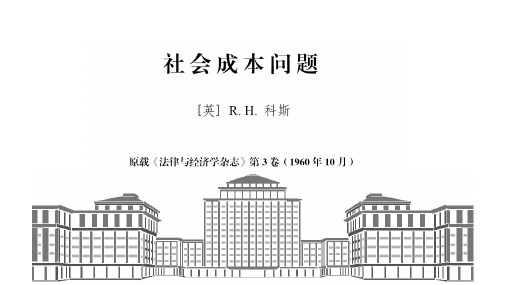
还是政府部门)的操作成本。在设计和选择社会安排时,我们应考虑总的效果。——研究方法的改变
启示 &
“决定迁移到工厂附近的人们并不考虑他们迁来所导致的产值的下降,这种不考虑给他人带来成本的缺陷与工厂主不考虑其 烟尘污染给别人造成的损害的性质是一样的。”
1 方法的改变——社会成本 0
• 经济学家未能对解决有害效果问题得出正确结论,这并不简单地是由于 分析方法上的欠缺,而是根源于目前福利经济学的方法中存在的基本缺 陷。需要的是研究取向的改变。
两种组织: 1.企业取代市场;在企业内部,要素组合中的讨价还价被取消,行政指令取代了市场交易,企业活动的重新安 排不再是用契约对权利进行调整的结果,而是行政决定的结果。 2.政府直接管制;这不是制定可由市场调整权利的法律,而是强制规定人们必须做什么和不许做什么,并要求 人们必须服从。政府作为“超级企业”所拥有的权威可以减除不少麻烦,但这种办法也有成本,只有在其他办 法无效时才会被采用。 第三种。。。。。。
例子:糖果制造商的机器引起的噪声和震动干扰了某医生的工作、走失的牛损坏邻近土地里的
谷物所产生的问题、乔治·J·施蒂格勒教授提到的河流污染问题(简单提及,尚未分析)
科斯的想法:必须从总体的和边际的角度来看待这一问题
分析起点:案例分析 以往经济学观点:当造成损害的一方赔偿所有损失,并且定价制度是正常运 行时(定价制度的运行不需成本),就足以解决问题。
2019/09/17
0 问题的重新说明 5
为了阐明论点的本质,并表明其普遍适用性,进一步分析了四个实际案例
《社会成本问题》以及“科斯定理”的一些理解
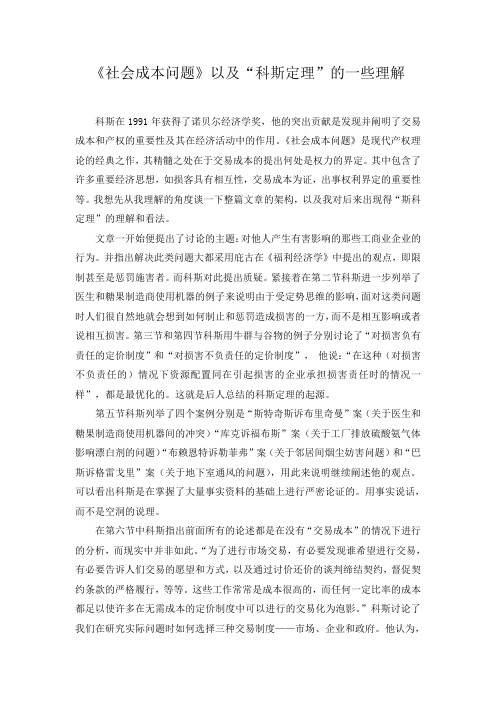
《社会成本问题》以及“科斯定理”的一些理解科斯在1991年获得了诺贝尔经济学奖,他的突出贡献是发现并阐明了交易成本和产权的重要性及其在经济活动中的作用。
《社会成本问题》是现代产权理论的经典之作,其精髓之处在于交易成本的提出何处是权力的界定。
其中包含了许多重要经济思想,如损客具有相互性,交易成本为证,出事权利界定的重要性等。
我想先从我理解的角度谈一下整篇文章的架构,以及我对后来出现得“斯科定理”的理解和看法。
文章一开始便提出了讨论的主题:对他人产生有害影响的那些工商业企业的行为。
并指出解决此类问题大都采用庇古在《福利经济学》中提出的观点,即限制甚至是惩罚施害者。
而科斯对此提出质疑。
紧接着在第二节科斯进一步列举了医生和糖果制造商使用机器的例子来说明由于受定势思维的影响,面对这类问题时人们很自然地就会想到如何制止和惩罚造成损害的一方,而不是相互影响或者说相互损害。
第三节和第四节科斯用牛群与谷物的例子分别讨论了“对损害负有责任的定价制度”和“对损害不负责任的定价制度”,他说:“在这种(对损害不负责任的)情况下资源配置同在引起损害的企业承担损害责任时的情况一样”,都是最优化的。
这就是后人总结的科斯定理的起源。
第五节科斯列举了四个案例分别是“斯特奇斯诉布里奇曼”案(关于医生和糖果制造商使用机器间的冲突)“库克诉福布斯”案(关于工厂排放硫酸氨气体影响漂白剂的问题)“布赖恩特诉勒菲弗”案(关于邻居间烟尘妨害问题)和“巴斯诉格雷戈里”案(关于地下室通风的问题),用此来说明继续阐述他的观点。
可以看出科斯是在掌握了大量事实资料的基础上进行严密论证的。
用事实说话,而不是空洞的说理。
在第六节中科斯指出前面所有的论述都是在没有“交易成本”的情况下进行的分析,而现实中并非如此。
“为了进行市场交易,有必要发现谁希望进行交易,有必要告诉人们交易的愿望和方式,以及通过讨价还价的谈判缔结契约,督促契约条款的严格履行,等等。
这些工作常常是成本很高的,而任何一定比率的成本都足以使许多在无需成本的定价制度中可以进行的交易化为泡影。
科斯-《社会成本问题》(中文版)
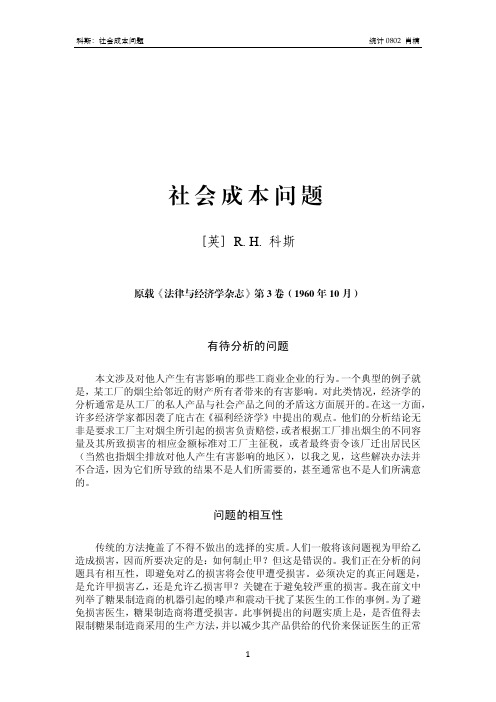
社会成本问题[英] R. H. 科斯原载《法律与经济学杂志》第3卷(1960年10月)有待分析的问题本文涉及对他人产生有害影响的那些工商业企业的行为。
一个典型的例子就是,某工厂的烟尘给邻近的财产所有者带来的有害影响。
对此类情况,经济学的分析通常是从工厂的私人产品与社会产品之间的矛盾这方面展开的。
在这一方面,许多经济学家都因袭了庇古在《福利经济学》中提出的观点。
他们的分析结论无非是要求工厂主对烟尘所引起的损害负责赔偿,或者根据工厂排出烟尘的不同容量及其所致损害的相应金额标准对工厂主征税,或者最终责令该厂迁出居民区(当然也指烟尘排放对他人产生有害影响的地区),以我之见,这些解决办法并不合适,因为它们所导致的结果不是人们所需要的,甚至通常也不是人们所满意的。
问题的相互性传统的方法掩盖了不得不做出的选择的实质。
人们一般将该问题视为甲给乙造成损害,因而所要决定的是:如何制止甲?但这是错误的。
我们正在分析的问题具有相互性,即避免对乙的损害将会使甲遭受损害。
必须决定的真正问题是,是允许甲损害乙,还是允许乙损害甲?关键在于避免较严重的损害。
我在前文中列举了糖果制造商的机器引起的嗓声和震动干扰了某医生的工作的事例。
为了避免损害医生,糖果制造商将遭受损害。
此事例提出的问题实质上是,是否值得去限制糖果制造商采用的生产方法,并以减少其产品供给的代价来保证医生的正常工作。
另一事例是走失的牛损坏邻近土地里的谷物所产生的问题。
倘若有些牛难免要走失,那么只有以减少谷物的供给这一代价来换取肉类供给的增加。
这种选择的实质是显而易见的:是要肉类,还是要谷物?当然,我们不能贸然回答,除非我们知道所得到的价值是什么,以及为此所牺牲的价值是什么。
再举一例:乔治·J·施蒂格勒教授提到的河流污染问题。
如果我们假定污染的有害后果是鱼类的死亡,要决定的问题则是:鱼类损失的价值究竟大于还是小于可能污染河流的产品的价值。
不言而喻,必须从总体的和边际的角度来看待这一问题。
社会成本问题-科斯

社会成本问题-科斯《社会成本问题》读后感我找了多遍科斯的论文,发现科斯一生并没有出版系统的理论性书籍,他的主要思想均体现在自己的论文、演讲中,以及其跟随者的总结中。
这篇《社会成本问题》则比较突出体现了其对于交易成本概念的阐述,值得深入研究。
科斯在这篇文章中谈及了经济外部性、初始产权设置等问题,他认为如果社会交易成本为0,那无论产权界定给谁,其结果都能实现产出最大化,因为交易双方总能制定一个令双方都满意的价格,从而使产权得以圆满界定。
同理,经济外部性的问题也可利用这个理论来解决,甲侵害了乙的利益,并不需要政府的介入,或者对于甲的强制措施,。
甲乙双方在交易成本为零的状况下,可以自行进行磋商,甲可以支付给乙一定的补偿,而乙可以继续忍受甲的行为,前提是甲在支付补偿之后,仍然有利可图,否则他便将推出该市场。
科斯在这里为我们提出了一个全新的视角,抛开福利和道德的约束,用纯粹经济学的观点思考社会问题,这的确是充满新意的,它避免了传统说教色彩的规劝,转而引入经济人的假设进入到外部性的领域,他给予了这样一种见解,侵害别人的行为是可以被交易的,只要存在这样的市场以及为了达成这个交易的成本为零,那么问题是可以解决的,没有一方会受损。
几个比较经典的例子也说明了以上的观点但是交易费用为零的假定是很不现实的。
为了进行市场交易,有必要发现交易对象,有必要交流交易的愿望和条件,以及通过讨价还价的谈判缔结契约,特别是督促契约条款的严格履行等等。
相较于传统的福利经济学家,我认为科斯还是主张政府“守夜人”职责的,即政府应该明确其职责是使产权明晰,然后是交由私人市场去取得有效率的结果。
而只要提供给私人市场一个可以自由交易外部性的市场,那么那些看似非常复杂的问题都可以得到迅速的解决。
但在这里,我却有非常大的质疑,科斯所假设的是存在着这样的市场,使得外部性可以被交易。
但现实生活中则根本不存在这样的市场,由于信息、地域、政治、文化和经济发展条件的限制,根本不存在着这样一种可以自由交易的市场,利益相关的双方不可能得到这样一种机会平心静气的谈论问题,而且还要在完全信息的保证之下,这些条件是过于苛刻的,以至于我们可以断定不存在着这样的市场,它只可能存在于单独个人之间或偶然的简单事件中。
科斯定理:“社会成本问题”中的案例
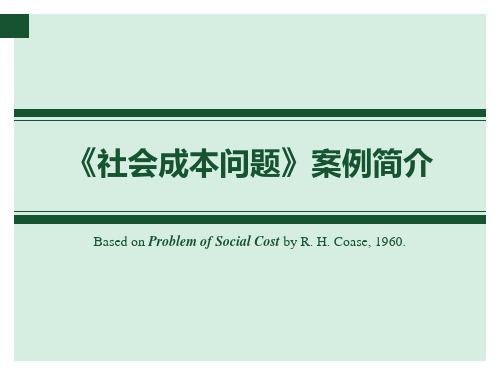
《社会成本问题》案例简介Based on Problem of Social Cost by R. H. Coase, 1960.目录•问题的引入•农夫与养牛人的案例•延伸与思考•糖果制造商和医生的官司:-新诊所深受噪音困扰-法官判定医生胜诉——“严格贯彻本判决所依据的原则会给个人带来痛苦,但是,否定该原则甚至将导致更多人的痛苦,同时对住宅土地的开发会产生不利的后果。
”•其它的解决方案?可否让两者和睦共处?-制造商付钱给医生:钱的数目> 新诊所迁移给医生造成的成本(医生不在此地看病带来的成本,抑或砌一堵隔音墙的成本。
)-另一方面必须满足:钱的数目< 制造商的种种成本(改变生产方式,停止生产,搬迁他处等等)“商量的余地”(在医生胜诉时)给医生造成的成本< 制造商付钱数目< 给制造商造成的成本(取决于双方的讨价还价能力)•如果判决反过来:制造商胜诉会怎样?-制造商有权继续按原来方式使用机器-医生不得不向开发商支付一笔钱以解决噪音问题•商量的余地何在?制造商停止生产的损失< 医生付钱数目< 噪音存在时医生的损失•“在市场交易成本为零的情况下,法院有关损害责任的判决不会影响资源的配置。
”•“法官们关于如何利用土地的观点,只有在必要的市场交易成本超过权利的任何重新安排所能得到的收益时,才是有益的。
”•科斯认为,传统的方法掩盖了选择的实质性问题:-甲的行为对乙造成损害,而制止甲对甲也是有损害的(是否值得限制糖果制造商来保证医生正常工作?)(损失的鱼类的价值和造成河流污染的产品的价值,谁更大?)-关键在于避免较严重的损害:利用市场机制和商量的余地•“法官们关于如何利用土地的观点,只有在必要的市场交易成本超过权利的任何重新安排所能得到的收益时,才是有价值的。
”•基本假设:-农夫和养牛人在各自土地上从事生产活动-牛会对谷物造成损失-双方都可以选择建造栅栏避免牛对谷物造成损失($9)-社会交易成本为零-每吨谷物价格为$1牛的数目(头)谷物年损失(吨)每增加一头牛造成的谷物损失(吨)1112323634104牛的数目与谷物年损失之间的关系1.假定养牛者承担损害谷物的责任-扩大牛群的依据:追加牛数量的收益> 损坏谷物的附加成本-注意:①当养牛者希望拥有4头或更多的牛,他会选择装栅栏。
社会成本问题(科斯)

2.2 对损害不负责任的定价制度
基本观点
初 始
牛群数(头)
农夫赔付($)
2❖ 造成损害的一方3不赔偿损失保持2头
❖ 定价制度正常运行
1
5
头
0
案例
6 走失的牛损坏邻土谷物生长
养牛者获$3,
这$3表示增加第3 头牛所需成本的一 部分。
牛群数3(如头)果养牛农者夫必赔3须付(支$付)赔偿,结果也一养样牛。者收额外$3,
2.3 问题的重新说明
案例 草席制造商VS.硫酸铵制造商
经济分析与牛损害谷物的情况完全相同。
2.3 问题的重新说明
案例 邻里烟尘妨害
谁引起了烟尘妨害? 造墙者与生火者共同引起。 (因果关系) 想达到资源的最优配置, 在判定双方当事人的行动时需考虑他 们所带来的损害影响。
产权
产权 (Property Rights)
合法权利的初 始界定,影响 经济制度的运 行效率。
替代性的经济组 织形式,低于市 场交易成本。 (企业的性质)
3 对市场交易成本的考察
市场
通过市场调整合法权利,产值增长多于带来 的交易成本。
企业
企业行政成本低于所替代的市场交易成本, 企业活动收益多于企业组织成本。
政府
当外部损害涉及多人,通过市场和企业解决 问题的成本很高时。
Ⅱ
分析的出发点定 在实际存在的情 况,来审视政策 变化的效果。
Ⅲ
生产要素是行使 一定行为的权利。
5.3 结论
只有得大于失的行为才是人们追求的。
导致某些决策改善的现有制度的变化也会导致 其他决策的恶化。
必须考虑各种社会格局的运行成本,以及转成 一种新制度的成本。
在设计和选择社会格局时应考虑总的效果。
科斯 社会成本问题 读书笔记

科斯——社会成本问题在《社会的成本问题》中,科斯提出了在外部性存在的情况下,政府应该怎么办的理论,具体问题如下:当工厂排污对相关居民造成侵害的问题时,政府采取对工厂要求赔偿、征税、责令搬迁的措施是否有其合理性?科斯认为在这种外部性存在的情况下,这种损害是相互性的:若甲对已造成损害,制止甲则会对甲造成损害,问题的实质便转化为是允许甲损害乙,还是允许乙损害甲?他认为应从边际成本与收益的角度来看待这一问题。
关键在于避免较严重的损害,获得更多的产值。
而交易成本的存在与否对资源的配置可能会产生截然不同的结果。
他指出:一项制度的制定的目标不应该是损害最小化,而应该是产值最大化。
从两个方面分析了产权的赋予对资源配置效率的效应:一、交易成本为零的情况他从有权获得赔偿和无权获得赔偿两方面分析,指出在交易成本为零的时候,不论产权赋予谁,其结果都是一样的,均会达到生产值最大的情况即资源得到了最优配置,从而为交易成本理论奠定了基础。
因此在交易成本为零的情况下,政府采取的措施对资源的配置会在市场的情况下无效,从而使不必要的。
二、交易成本不为零的情况在现实生活中,达成一项交易是要耗费各种各样的成本的,这种成本如此之高以至于有时候不能在价格的指引下,使资源达到最优的配置。
这时候权利的界定将会对资源配置产生影响,法律直接影响着经济行为。
科斯认为不同的制度安排会导致不同的效率,且各种制度安排都是有成本的。
在这种情况下,没有证据可以证明通过政府法令(而非企业、市场)的形式配置资源效率是高的。
在这种情况下,应从成本---收益角度对每种制度进行分析,选择一种收益成本之差最大的制度措施。
科斯认为我们在处理有损害后果的行为时,并不应该简单地限制那些有责任者。
而应该考虑的是该项措施的实施的收益是否大于该损害行为的成本。
科斯分析了庇古《福利经济学》中的内容,他认为福利经济学一般把注意力放在分析外部侵害所造成的私人产品与社会产品之间的差异上,从而论证了市场制度的缺陷,以及采取政府管制的必要性。
社会成本问题读书笔记
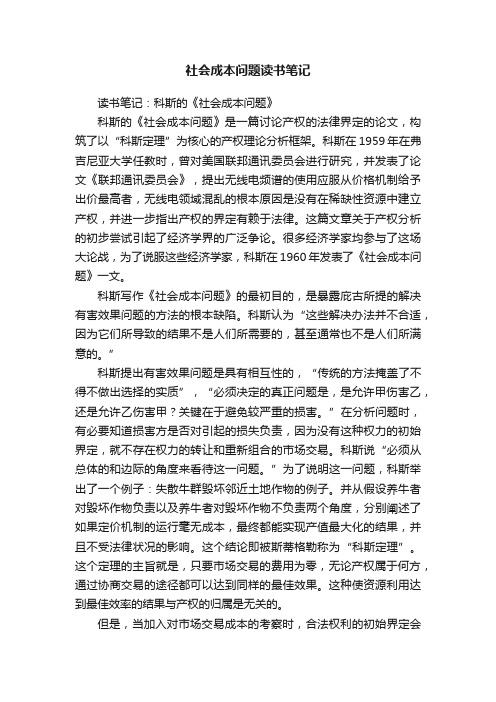
社会成本问题读书笔记读书笔记:科斯的《社会成本问题》科斯的《社会成本问题》是一篇讨论产权的法律界定的论文,构筑了以“科斯定理”为核心的产权理论分析框架。
科斯在1959年在弗吉尼亚大学任教时,曾对美国联邦通讯委员会进行研究,并发表了论文《联邦通讯委员会》,提出无线电频谱的使用应服从价格机制给予出价最高者,无线电领域混乱的根本原因是没有在稀缺性资源中建立产权,并进一步指出产权的界定有赖于法律。
这篇文章关于产权分析的初步尝试引起了经济学界的广泛争论。
很多经济学家均参与了这场大论战,为了说服这些经济学家,科斯在1960年发表了《社会成本问题》一文。
科斯写作《社会成本问题》的最初目的,是暴露庇古所提的解决有害效果问题的方法的根本缺陷。
科斯认为“这些解决办法并不合适,因为它们所导致的结果不是人们所需要的,甚至通常也不是人们所满意的。
”科斯提出有害效果问题是具有相互性的,“传统的方法掩盖了不得不做出选择的实质”,“必须决定的真正问题是,是允许甲伤害乙,还是允许乙伤害甲?关键在于避免较严重的损害。
”在分析问题时,有必要知道损害方是否对引起的损失负责,因为没有这种权力的初始界定,就不存在权力的转让和重新组合的市场交易。
科斯说“必须从总体的和边际的角度来看待这一问题。
”为了说明这一问题,科斯举出了一个例子:失散牛群毁坏邻近土地作物的例子。
并从假设养牛者对毁坏作物负责以及养牛者对毁坏作物不负责两个角度,分别阐述了如果定价机制的运行毫无成本,最终都能实现产值最大化的结果,并且不受法律状况的影响。
这个结论即被斯蒂格勒称为“科斯定理”。
这个定理的主旨就是,只要市场交易的费用为零,无论产权属于何方,通过协商交易的途径都可以达到同样的最佳效果。
这种使资源利用达到最佳效率的结果与产权的归属是无关的。
但是,当加入对市场交易成本的考察时,合法权利的初始界定会对经济制度的运行效率产生影响。
科斯早就在《企业的性质》一文中指出,市场交易是有成本的,所以科斯更倾向于将“科斯定理”看作是“分析具有正交易费用的经济路途中的一块垫脚石,以便进一步分析一个有正交易费用的经济”。
科斯社会成本问题文献ppt

• 第二种情况 谷物价值=10,耕种成本=11 结果: 当没有出现养牛者的情况下,土地荒芜; 当出现养牛者,并假设土地被耕种,且谷 物全被牛群破坏时,农夫损失1,养牛者损 失10,此种情况不会长久
四、对损害不负责任的定价制度
• 前提:定价制度顺利,即成本为零 • 引起损害的企业对损害结果并不承担责任, 不对其造成的损害支付赔偿费 • 例:同上
对于养牛者
• 边际的角度:当牛群由2头增加到三头时, MC1=3,当MR1>MC1时,养牛者扩大牛群 • 总的角度:当牛群有4头牛时,C1=10,此时, TC=C1+… 而当有任何用来减少侵害的方法的C<10,就 会被采用,从而提高了养牛者的利润
对于农夫:养牛不会使其增加产量(两种情况) • 第一种情况 谷物的价值=12,耕种成本=10,净利润=2 当有养牛者时,谷物损失=1,此时净利润=? 在这种情况下,产量不变 牛肉的行情好,养牛者最多愿意支付3 此时农夫愿意放弃耕种,产量减少 2≤ x ≤3
• 总结:在考虑交易成本的情况下,合法权利的初 始界定会对经济制度运行的效率产生影响。权利 的一种调整,会比其他安排产生更多的产值。 • 科斯具体分析了市场、企业、政府三种不同的解 决方式,他认为:当通过市场调整合法权利后, 产值的增长多于它带来的交易成本时,市场就是 有效的;当企业的行政成本低于它所替代的市场 交易成本,企业活动的调整所获得的收益多于企 业的组织成本时,通过企业是可行的;当外部损 害涉及很多人,因而通过市场和企业解决问题的 成本很高时,通过政府是有利的,但政府管制不 是没有成本的。关键是看,哪一种安排交易成本 更小,总产值更大。
2、企业作为替代市场交易来组织生产的组织,也 就是说,当企业内部组织交易的行政成本低于市 场交易成本的时候,企业就成为了代替市场交易 来完成资源(权替代制度是政府的直接管制,强制性地 规定人们必须做什么或不得做什么,以及什么是 必须遵守的。 在某种意义上,政府是一个超级企业,它能通过 行政决定影响生产要素的使用。但是,显然,政 府有能力以低于私人组织的成本进行某种活动, 但政府行政机制本身并非不要成本
- 1、下载文档前请自行甄别文档内容的完整性,平台不提供额外的编辑、内容补充、找答案等附加服务。
- 2、"仅部分预览"的文档,不可在线预览部分如存在完整性等问题,可反馈申请退款(可完整预览的文档不适用该条件!)。
- 3、如文档侵犯您的权益,请联系客服反馈,我们会尽快为您处理(人工客服工作时间:9:00-18:30)。
社会成本问题-科斯《社会成本问题》读后感我找了多遍科斯的论文,发现科斯一生并没有出版系统的理论性书籍,他的主要思想均体现在自己的论文、演讲中,以及其跟随者的总结中。
这篇《社会成本问题》则比较突出体现了其对于交易成本概念的阐述,值得深入研究。
科斯在这篇文章中谈及了经济外部性、初始产权设置等问题,他认为如果社会交易成本为0,那无论产权界定给谁,其结果都能实现产出最大化,因为交易双方总能制定一个令双方都满意的价格,从而使产权得以圆满界定。
同理,经济外部性的问题也可利用这个理论来解决,甲侵害了乙的利益,并不需要政府的介入,或者对于甲的强制措施,。
甲乙双方在交易成本为零的状况下,可以自行进行磋商,甲可以支付给乙一定的补偿,而乙可以继续忍受甲的行为,前提是甲在支付补偿之后,仍然有利可图,否则他便将推出该市场。
科斯在这里为我们提出了一个全新的视角,抛开福利和道德的约束,用纯粹经济学的观点思考社会问题,这的确是充满新意的,它避免了传统说教色彩的规劝,转而引入经济人的假设进入到外部性的领域,他给予了这样一种见解,侵害别人的行为是可以被交易的,只要存在这样的市场以及为了达成这个交易的成本为零,那么问题是可以解决的,没有一方会受损。
几个比较经典的例子也说明了以上的观点但是交易费用为零的假定是很不现实的。
为了进行市场交易,有必要发现交易对象,有必要交流交易的愿望和条件,以及通过讨价还价的谈判缔结契约,特别是督促契约条款的严格履行等等。
相较于传统的福利经济学家,我认为科斯还是主张政府“守夜人”职责的,即政府应该明确其职责是使产权明晰,然后是交由私人市场去取得有效率的结果。
而只要提供给私人市场一个可以自由交易外部性的市场,那么那些看似非常复杂的问题都可以得到迅速的解决。
但在这里,我却有非常大的质疑,科斯所假设的是存在着这样的市场,使得外部性可以被交易。
但现实生活中则根本不存在这样的市场,由于信息、地域、政治、文化和经济发展条件的限制,根本不存在着这样一种可以自由交易的市场,利益相关的双方不可能得到这样一种机会平心静气的谈论问题,而且还要在完全信息的保证之下,这些条件是过于苛刻的,以至于我们可以断定不存在着这样的市场,它只可能存在于单独个人之间或偶然的简单事件中。
那么科斯对于政府职责的定义就存在着问题,我觉得政府恰恰扮演了这样一种角色,即建立了一个虚拟市场,使得外部性可以得到交易,它通过奖惩制度使得外部性得以解决,尽管也存在着诸多的问题,但总比人们漫无目的的讨价还价来的有效率一些。
这是我现在的一些感受,还有很多地方没有看懂,希望以后能接受老师的指点。
生活中的案例生活中许多现象都存在着制度的影子,很多问题都可以通过制度的观点加以解读。
远的不说,可以观察宿舍管理制度。
每周三,寝室管理员都会例行检查卫生,但同学们却缺乏收拾宿舍的动力,以至于恶性循环,宿舍卫生变得很差。
从侧面可以看出,学校的宿舍管理工作并没有做到实处,也就是制度的不完善,缺乏必要的奖惩机制,收拾得好的宿舍并没有得到实质性的奖励,而卫生差的宿舍也没有动力予以改观,因为改变不存在着任何有利的地方。
为解决这个问题,学校的领导们应该更为清楚的认识到激励机制的重要性,充分把学校的目标同学生的目标结合好,才能达到更好的绩效。
读《企业、市场与法律》的一点理解和思考经济学院08 经济班贾宇208310711《企业、市场与法律》一书是为了全面系统地反映当代经济学的全貌以及其进程,总结与挖掘当代经济学已有的和潜在的成果,展示当代经血新的发展方向而出版的。
收录了罗纳德·哈里·科斯的七篇论文。
《企业、市场与法律》的核心是《企业的性质》、《边际成本的论争》和《社会成本问题》,其余几篇或拓展、或说明、或解释了上述三篇文章的观点。
科斯作为新制度经济学的开山鼻祖,其《企业的性质》也被认为是新制度经济学的开山之作。
作为初接触新制度经济学这个领域的学生,我主要阅读了该书的三个核心章节。
但由于所掌握的经济学知识有限,加之视野较窄,对于制度经济学领域的经典著作并没有十分理解。
现就我在读书过程中的一点所得作以陈述。
在科斯之前,一直没有哪位经济学家很好的解释了为什么经济活动除了依赖价格协调外,还要依赖于企业家的协调。
当时,很多经济学家甚至不理解或不接受科斯看待经济问题的方法,认为企业家的协调是多此一举。
在科斯看来,市场价格机制实际上是参加交易的主题间的契约过程。
在按市场价格达成交易之前,交易者必须知道什么才是合适的市场价格,必须充分了解市场信息,而这是有代价的。
真实的价格机制是有费用的,而企业家的协调正是作为价格机制的替代物,即当企业家协调能够比市场价格机制的交易费用更低时,企业就会产生,而交易就在企业内部进行。
科斯认为,企业是一种长期的权威性契约关系,它使某一生产要素不必与企业内部其他的一些生产要素签订一系列契约。
所以,企业简化了契约关系,从而节省了交易费用。
但企业不是万能的,此处,科斯解释到“当企业扩大时,对企业家的功能来说,收益可能会减少,也就是说,在企业内部组织追加交易的成本,可能会上升。
自然,企业的扩大必须达到这一点,即在企业内部组织一笔额外交易的成本等于在公开市场上完成这笔交易的成本。
”在他看来,市场上存在着许多企业家,所以单个企业家不会包揽一切交易,企业与企业之间的市场均衡由其交易费用的高低决定。
此处我并不是很理解,对于经济学的辩证逻辑,我还没有很好掌握。
科斯作为第一位发现交易费用的人,科学的解释了厂商为什么存在。
作为我个人来讲,实际上我并未真正读懂科斯定理的精髓,没有感受到许多经济学家所说的如此强烈的震撼。
在该书的相关章节中,对于老师课堂上所讲的案例以及有关制度经济学的一些基本概念有了进一步的了解。
我想,作为经济学专业的学生,我还应该进一步扩大自己的阅读范围和知识面,多接触才能更深刻的理解经济学的精髓。
以上就是我在读《企业、市场与法律》一书中所得到的。
都是浮之于文字表面的浅层理解,希望对于自己今后的制度经济学的学习能有所帮助。
读《企业的性质》有感在开始接触制度经济学时,就看到网上说科斯的《企业的性质》是新制度经济学的奠基之作,故就通过对这篇文章的阅读来领自己进门。
在这篇论文中,科斯解释了一个重要的问题,即企业存在的合理性。
针对市场机制的完善性假设,科斯提出了为什么还会存在企业,例如机械制造行业,如果所有零件都可以购买,那么人们可以直接建立组装厂,为什么还要存在大型企业来自己生产零部件?科斯的解释是,市场上的交易有时代价很大,如果将交易内部化,则交易成本会大大降低。
他说:“建立企业有利可图的主要原因似乎是,利用价格机制是有成本的。
通过价格机制‘组织’生产的最明显的成本就是所有发现相对价格的总和。
随着出卖这类信息的专门人员的出现,这种成本有可能减少,但不可能消除。
市场上发生的每一笔交易的谈判和签约的费用也必须考虑在内。
”这种交易代价,我认为就是科斯提到的市场机制的完善性,根据我们以前产业组织理论中学习的知识,在完全竞争市场上,各企业的利润趋于零,这时我们才能说市场机制是完善的。
但是,这样的市场是不存在的,现实社会中,由于地域差距,运输成本,信息不对称等,导致交易成本不可能为零,在这种情况下企业的存在可以降低交易成本。
故,书中得出了这样的结论,即企业随交易成本而存在,交易成本随市场完善程度而存在,当市场完善时,交易成本趋于零,企业存在意义不大,但当市场不完善,交易成本较大时,企业的存在可以优化资源配置。
同时我认为,在经济学假设下,企业的规模越大越可以降低成本。
因为当一个企业可以包揽所有的制作、销售环节,体现为纵向合并时,可以将所有的中间环节成本降低,最终达到降低总成本,提高利润率的目的。
然而,由于目前社会上自然禀赋、地理因素的差异,使得这种经济学假设无法实现。
但是我认为,随着科学技术的发展,这必将成为一种发展趋势。
读科斯《社会成本问题》的思考阅读了科斯的这篇文章,在我理解,它主要是对交易成本和外部性的问题进行阐述。
对于选择哪一种交易机制(市场、企业、政府)更有效的问题,科斯认为没有谁优于谁,选择的标准只有比较各种机制之间的交易成本。
对于外部性,传统的观点是政府对造成这一外部性的企业或者个人征收罚款,而科斯认为这样做同时损害了双方,不能带来社会总福利的增加。
科斯提出了解决问题的新思路,即如何使损失最小化。
看完科斯在这篇文章中提到的案例,我得到启示是:在法院判理此类案件时,不应草率的归责于打破双方原有状况的一方,原告与被告均可能承受损失,要充分考虑各方损失大小再下结论。
最佳产权界定刚刚起步学习制度经济学,对于制度一词还不甚了解,只是模糊知道科斯是制度经济学的开山鼻祖,对闻名遐迩的科斯定理也只是有一丁点的了解。
于是拜读了一下盛洪老师对于科斯定理的解读,对于他从《社会成本问题》中存在问题的解读,也稍稍有自己的一点看法。
我们都知道,科斯第一定理中,如果交易成本为零时,法律上的初始产权界定无论如何界定,都不会影响社会总产出的最大化。
在盛洪老师的论文《“社会成本问题”的问题》中,他提到,虽然初始产权的界定不会影响社会总产出的最大化,但是一种产权界定与另一种产权界定是否是不同的?是否存在一种最佳的产权界定?在这篇论文中,盛洪老师得出的结论是,一种界定可能比另一种更有效率,并且存在着最佳产权界定。
而且可以通过劳动规则和占先规则来确定最优产权。
按照盛洪老师的说法,我们把这种确定最优产权的方法带入课上所学的案例中,可以发现,关键不在于,法律规定了谁是造成损害的一方,而是,谁的行动改变了既定的利益格局。
在农夫与放牛者的故事中,如果一开始,土地是农夫所有,那么当牛群跑入土地时,放牛者就改变了原先的利益格局,那么他就要负赔偿责任。
排污的工厂与附近居民的故事中,如果在一个居民区新迁入了一个排污的工厂,给居民带来了新增的损失,那么工厂就要负责任。
如果是居民迁到排污的工厂附近,由于他们自己的行为而带来了增加的损失,那么工厂无需负责任。
反过来再看科斯定理,我们可以发现,在科斯那里,资源的初始产权掌握在知道资源最佳用途的人手里,这就与实际有些脱节了。
所以,究竟怎样把理论运用到实际当中,需要我们不断的改进理论和磨合。
08经济王冰 2008310692315期间贾平凹、刘心武、阎连科、韩寒、郭敬明、李承鹏等近50位中国作家联合发表讨百度书,指责百度文库以“免费分享”为借口,侵犯作家权益。
25日下午部分出版业及作家代表与百度公司就百度文库涉嫌侵权盗版一事进行的谈判失败。
声明提到:在大约一年以前,百度MP3开始提供免费音乐,每个人都可以免费下载流行歌曲。
这事有一个严重后果,它直接导致了中国唱片业的整体萎缩。
“如果所有的歌者都不再歌唱,仅剩一个百度MP3,它还有什么可供分享?”声明说,我们蔑视这种所谓的“免费分享”,它只是个借口,它伤害的是我们每个人,每个作者和每个读者。
